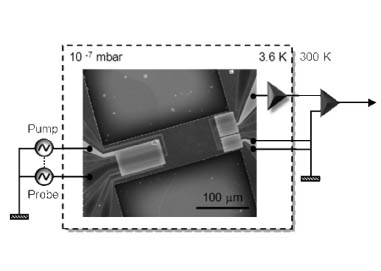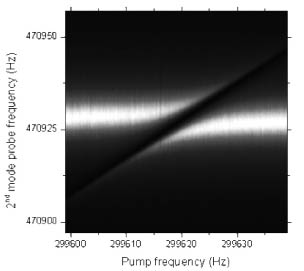Ā@
Physical Science Laboratory
Cavity-opto/electromechanical systems exploit the parametric
coupling between a photonic cavity and a mechanical resonator [1]. The
parametric coupling arises from the motion of the mechanical element that
can modulate the cavityĀfs frequency. This results in the emergence of side-bands
at the sum (blue) and difference (red) frequency of the constituent resonators.
By optically pumping on the side-bands, the coupling between the two systems
can be enhanced. This in turn can induce an EIT-like transparency in the
cavity where energy is transferred to the mechanical resonator. Alternatively,
the cavity can also manipulate the oscillation dynamics of the mechanical
resonator and even cool it into its quantum ground state i.e. energy is
transferred to the cavity from the mechanical resonator.
In this work, we demonstrate an all-phonon analogue of a photonic cavity-opto/electromechanical system where the mechanical oscillation of interest is composed by the 1st oscillation mode and role of the phonon cavity is played by the 2nd oscillation mode. The parametric coupling between the modes is created by modulating the tension in the electromechanical resonator at the sideband frequencies. This in turn modifies the oscillation dynamics of the constituent modes that can drive the parametric coupling between them.
The experiments were performed in a piezoelectrically
active GaAs/AlGaAs electromechanical resonator which sustained the 1st
and 2nd modes at 171.3 kHz and 470.9 kHz respectively (Fig. 1). The piezoelectric
transducer enabled the tension in the mechanical resonator to be modulated
at the sidebands. The creation of parametric coupling is demonstrated by
probing the 2nd mode whilst pumping on the red-side band (see Fig. 2).
This results in energy from the 2nd mode being transferred to the 1st mode.
As the pump amplitude is increased, the coupling between modes is made
so strong that it results in parametric normal mode splitting where the
modes are no longer distinct but rather a hybrid. We exploit the dynamic
nature of this parametric coupling to create a transparency in the phonon
cavity and to cool the 1st mode [2].
[1] T. Kippenberg and K. Vahala, Science 321 (2008) 1172.
[2] I. Mahboob et al., Nature Physics 8 (2012) 387.
Ā@
 |
 |
|||||
|
|